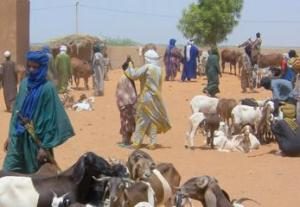
LMIS: Livestock Marketing Information System
Developing reliable, timely livestock market information for the development of East African countries
A need for reliable, timely market information


The livelihood of a vast majority of people in eastern Africa is highly dependent on income from livestock and livestock products. Therefore, the development of reliable and timely livestock market information is vital for the development of the countries in the region and provides a basis for livestock producers and traders to make marketing decisions.
The Problem
In the past few years, the urgency to address the needs of livestock-keeping communities in eastern Africa has risen dramatically, prompting national governments, NGOs and international donors to explore high impact interventions. Given the high dependency of livestock keepers’ family livelihoods on cash income from the sale of livestock and livestock products, the institutional focus has been directed toward improving livestock market information, infrastructure, and efficiency.
An extensive review of the wide array of livestock market development activities in eastern Africa revealed a lack of viable livestock market information system to support decision making of traders, producers and policymakers. A reliable market information system creates transparency and a basis for the livestock keepers to make marketing decisions.
Steps Toward A Solution
With funding support from USAID, the Livestock Information Network and Knowledge System (LINKS) of the Global Livestock Collaborative Research Support Program (GL-CRSP) has developed an Information Communication and Technology (ICT) system to extend the technical and human capacity to meet livestock information needs to support decision-making for livestock producers, traders, and policymakers in East Africa.
Using a partnership approach with existing livestock marketing institutions in the eastern Africa region, LINKS has designed and is delivering a livestock information and communication technology that provides monitoring and analysis technology to foster strategic partnerships between livestock keepers, markets and policy. Autonomous systems with near real-time databases have been established in Kenya (http://www.lmiske.net) Tanzania (http://www.lmistz.net) and Ethiopia (http://www.lmiset.net). Additionally, given the cross-border nature of livestock trade, the project offers a regional framework where countries involved can collaborate, network and share experiences.
How it Works
One of the major aims of the LINKS project is to determine the application of and usefulness of integrated spatial, information, and communications technologies in improving the livestock market information infrastructure in eastern Africa.
The LINKS project is built around emerging information technology coupled with spatial models of livestock movement and expected prices and volumes at secondary and terminal markets to add value to the market information system.
The spatial information and communication toolkit includes Global Positioning System (GPS), mobile phones, Worldspace radios, computing analysis, and web-based platforms. Integration of these tools makes it possible for the system to carry out market chain analysis indicating the source of animals, the time taken to truck them and the associated costs of getting them to designated markets.
Obtaining Market Data
Market monitors are trained in the use of livestock market data collection formats and are given instructions and guidance on the proper ways of approaching sellers, brokers, and traders to collect reliable data in an effective way. The monitors are provided with mobile phones and scratch cards to enable them to send the collected data to the database system.
Livestock prices and volumes are collected through interviews during the peak of a market day. A trained livestock market monitor interviews five cases of each of the dominant breed, class and grade combination of animal species on that market day. Average prices by animal kind, breed, class, and grade is then calculated along with the total volumes of livestock by animal kind and the information is coded and sent into the database system using SMS, e-mail or posted directly on the web into the database system.
